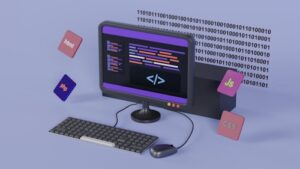Industrial systems thrive on precision and timing, but what drives that coordination often goes unnoticed. Behind the scenes, programmable logic controllers—or PLCs—quietly handle the critical decisions that keep automated lines productive. Understanding what is PLC programming reveals not only how machines communicate but also how subtle refinements in logic lead to measurable efficiency gains.
Enhanced Machine Throughput via Streamlined Logic Paths
Streamlined logic programming enables machines to complete operations faster without sacrificing stability. By organizing control sequences more efficiently, PLC programming eliminates redundant instructions and prioritizes high-frequency tasks. This approach reduces processing lag, ensuring each mechanical motion flows seamlessly into the next for smoother throughput across the production floor.
A well-structured custom PLC system processes signals with minimal delay, directly influencing cycle speed and machine responsiveness. In industries where seconds translate to higher output, optimized logic paths translate into measurable productivity gains. Engineers who understand these efficiencies can often reprogram older systems to match the pace of more modern Rockwell Allen Bradley PLC hardware, bringing legacy lines up to current performance standards.
Lowered Unscheduled Stoppages Through Embedded Diagnostic Routines
Unexpected downtime drains productivity and increases maintenance costs. PLC programming addresses this through embedded diagnostic routines that continuously monitor sensor feedback and actuator performance. By identifying potential faults early, the system alerts technicians before minor irregularities escalate into stoppages.
These diagnostics form part of a predictive maintenance approach that minimizes disruptions. Instead of reacting to breakdowns, maintenance teams act proactively, guided by real-time system data. In many cases, this results in thousands of saved production hours annually—a direct benefit of efficient control system integrators who understand how to embed fault detection into every logic loop.

Elevated Quality Output with Consistent Control Patterns
Production quality relies heavily on repeatable, predictable control. Through consistent logic patterns, PLCs ensure that processes run identically each time, reducing variability that can compromise finished goods. These stable sequences manage parameters such as temperature, pressure, and timing with exact precision, keeping outputs uniform from batch to batch.
Consistency not only stabilizes product quality but also simplifies compliance with internal quality standards. For manufacturers under strict performance tolerances, properly structured PLC programming maintains accuracy throughout high-volume production, ensuring the final product meets both design and safety specifications without manual oversight.
Energy Draw Reduction Achieved by Optimized Cycle Execution
Modern PLC systems reduce waste by optimizing the order and timing of power-consuming actions. A control program that eliminates idle motor runs, adjusts heater output, or synchronizes conveyor speeds contributes directly to lower energy usage. This improvement is built into the control logic rather than relying on external monitoring systems.
Such optimization can reduce plant-wide energy draw by double-digit percentages over time. Industrial facilities benefit not just from lower utility costs but from decreased equipment wear, as systems run only when needed. For organizations focused on sustainability, this represents one of the most efficient paths to achieving operational efficiency through programming discipline.
Expanded System Adaptability When Integrating Varied Equipment Types
Manufacturing environments often combine equipment from different generations and manufacturers. PLC programming bridges those gaps by creating communication pathways that allow diverse machines to function cohesively. This adaptability is key when integrating robotic systems, conveyors, or specialized process tools into a unified line.
Custom PLC design enables engineers to tailor communication protocols, making upgrades easier without requiring complete control overhauls. With well-coded logic, a new Rockwell Allen Bradley PLC can coordinate with older controllers or third-party automation systems, extending the life of existing machinery and improving return on investment.
Real-time Status Visibility Enabling Proactive Operational Adjustments
Modern PLCs collect and transmit operational data in real time, offering engineers immediate insight into system performance. By viewing live metrics through HMIs or SCADA systems, teams can identify inefficiencies or potential failures before they impact output. This visibility transforms production management from reactive to proactive.
Real-time data also enables decision-makers to adjust parameters dynamically, fine-tuning production rates, energy consumption, or quality control measures. The result is tighter control over day-to-day operations and an agile response to changing production demands—a hallmark advantage of well-integrated control systems.
Simplified Change-over Between Production Batches Reducing Downtime
For facilities running multiple product lines, change-over time directly affects profitability. PLC programming simplifies these transitions by automating sequence changes through recipe-based controls. Operators can switch between configurations at the push of a button instead of manually adjusting each component.
This efficiency is particularly valuable in food, packaging, and pharmaceutical manufacturing, where quick batch transitions maintain output levels. The ability to pre-program process variations into the control logic shortens downtime, maximizes uptime, and maintains consistent product quality between runs.
Tightened Regulatory Conformance Through Standardized Process Sequences
Regulated industries depend on documentation and repeatability. Standardized PLC code ensures that every step of a process follows a consistent, auditable pattern, reducing the risk of human error. Each function within the control logic can be validated against industry requirements, simplifying inspections and compliance reporting.
This approach not only satisfies oversight agencies but also strengthens traceability and accountability throughout production. By implementing uniform programming standards, control system integrators help businesses maintain both operational efficiency and regulatory confidence. For organizations aiming to modernize or refine automation systems, R.L. Consulting provides the technical expertise to design, implement, and optimize PLC programming that enhances both performance and compliance.





